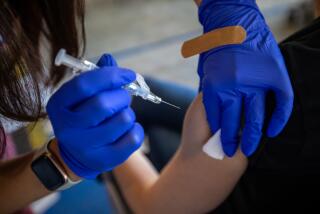How the flu vaccine turned out to be a poor match for this year’s flu

When it comes to developing a seasonal flu vaccine, researchers must take aim at an invisible target.
Not only are flu viruses constantly changing, drug manufacturers need to start producing their vaccines four to six months before the flu season starts. That means scientists must predict which virus will be most active months before it even appears.
Like weather forecasters, sometimes they get it right and sometimes they get it wrong. This season, it looks like they got it wrong.
On Thursday, the director of the Centers for Disease Control and Prevention warned that the flu shots and nasal sprays distributed this year may not be a good match for the most active virus now circulating in the U.S.
“One thing to understand about flu always is that it is unpredictable,” Dr. Thomas Frieden said. “Every season is different.”
Since Oct. 1, 82% of the influenza virus samples subjected to laboratory testing have been H3N2 viruses, according to data from the CDC. And only 48% of these samples are closely related to the A/Texas/50/2012 strain that was picked for the flu vaccine distributed in North America.
Most of the rest of the H3N2 samples were similar to another strain called A/Switzerland/9715293. That strain was picked for the flu vaccine for the Southern Hemisphere, but not the one here.
That means the vaccine — while still the best defense against the flu — is likely to offer less protection than in years past, Frieden said.
Health experts charged with monitoring flu viruses first detected strains of the A/Switzerland virus in the U.S. in March, Frieden said. By then, “it was already too late to include them in this season’s vaccine,” he said.
Besides, at that time, the A/Texas strains were still “by far the most common of the H3N2 viruses,” he said. The A/Switzerland strains didn’t appear in large numbers until September, he said.
Twice each year, the World Health Organization issues a recommendation for a flu vaccine — one for the Southern Hemisphere and one for the Northern Hemisphere. This approach gives health planners two opportunities to plan a vaccine.
“Our recommendations were made back in February because we need time to produce a vaccine, and that’s the problem,” said Dr. Arnold Monto, an expert on infectious diseases at the University of Michigan School of Public Health. “It’s the production lag.”
The flu vaccine contains samples of three or four weakened or deactivated viruses, enough to make the immune system swing into action and create antibodies. That way, if you encounter a real flu virus, your body will be prepared to fight it.
But as flu viruses mass-produce copies of themselves, they make tiny reproduction errors, or mutations. The mutations that cause headaches for researchers are the subtle changes that occur to the protein spikes that cover the surface of the virus.
These hemagglutinin spikes allow the virus to enter human host cells. When a vaccine has been properly formulated, the immune system will produce antibodies that recognize the spikes and latch onto them, essentially rendering the virus harmless.
But if the virus has mutated, or “drifted,” between the time the vaccine goes into production and when it’s finally distributed to the public, the antibodies can’t bind to their target protein, said Andrew Pekosz, a professor of microbiology at Johns Hopkins University Bloomberg School of Public Health.
“You get a virus which now can circumvent the pre-existing immunity,” he said.
Every year, 5% to 10% of adults and 20% to 30% of children around the world become sick with the flu, according to the World Health Organization. For most people, that means a week or two of fever, cough, runny nose, headache and pain in the muscles and joints. But in 3 million to 5 million cases, the flu can cause more severe illness, including 250,000 to 500,000 deaths.
In a good year, a seasonal flu vaccine can reach 70% efficacy. In a bad year, it can be much lower.
The vaccine for last year’s flu season had an overall efficacy between 50% and 55%, said Dr. Joseph Bresee of the CDC’s National Center for Immunization and Respiratory Diseases.
“In general our current influenza vaccine is a good vaccine, but it’s not a great vaccine,” Monto said. “We all recognize that we need improvement.”
Still, Frieden said Americans should get vaccinated if they haven’t already. “Though far from perfect, it still offers us the best chance for prevention,” he said.
That’s especially important this year, he added, since H3N2 viruses outnumber their H1N1 counterparts.
“H3N2 viruses tend to be associated with more severe seasons,” Frieden said. “The rate of hospitalization and death can be twice as high as or more than in flu season when H3 doesn’t predominate.”
Doctors should be prepared to prescribe antiviral drugs like Tamiflu and Relenza, which can shorten an infection by a day or more. “It can reduce the likelihood you’ll end up in a hospital or in intensive care, and ... reduce the risk of dying from influenza,” Frieden said.
Twitter: @montemorin







